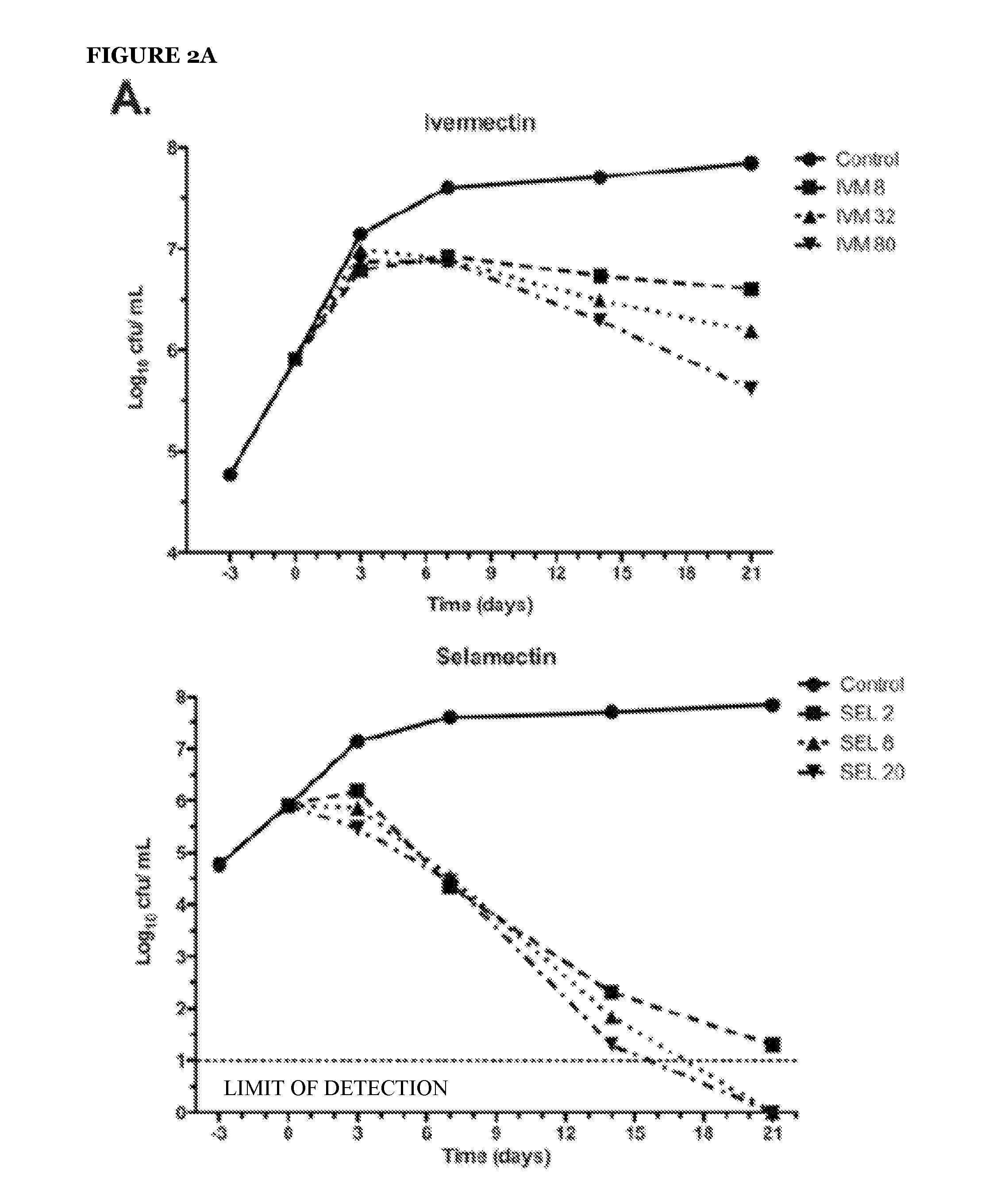Avermectins and Milbemycins as Anti-Mycobacterial Agents
a technology of mycobacterial agents and avermectins, which is applied in the field of new methods of treating mycobacterial infections, can solve the problems of inability to effectively treat patients, and inability to meet the needs of patients, and achieve rapid growth of mycobacterial bacteria, treatment or prophylaxis of infection
- Summary
- Abstract
- Description
- Claims
- Application Information
AI Technical Summary
Benefits of technology
Problems solved by technology
Method used
Image
Examples
example 1
Ivermectin, Selamectin, Moxidectin and Doramectin have Anti-Mycobacterial Activity, Including M. tuberculosis Drug-Susceptible, Multidrug-Resistant and Extensively Drug Resistant Strains, but not Gram-Positive and Gram-Negative Anti-Bacterial Activity
[0080]The antibacterial effectiveness of doramectin, ivermectin, moxidectin, and selamectin (FIG. 1) were examined against representative Gram-positive and Gram-negative bacteria (TABLE 3). Inhibitory effects were not observed on any of these bacteria at concentrations as high as 256 μg / ml using the bacterial growth indicator MTT [3-(4,5-dimethylthiazol-2-yl)-2,5-diphenyl tetrazolium bromide]. The avermectins and milbemycins were then tested for their inhibitory activities against various Mycobacterium species using the same MTT assay (Table 1). All three avermectins and the milbemycin moxidectin inhibited growth of Mycobacterium bovis BCG and M. tuberculosis laboratory strains (H37Rv, CDC 1551, and Erdman) at concentrations ranging fro...
example 2
Ivermectin, Moxidectin and Selamectin are Bactericidal in Vitro Against M. tuberculosis
[0082]To address the question of whether avermectins and milbemycins are bactericidal or bacteriostatic, survival kinetic experiments were done for ivermectin, selamectin, and moxidectin (see FIG. 2). Two experiments performed independently, under similar but not identical growth conditions, measured kill kinetics. In the first experiment (FIG. 2, Panel A), 21-day kill curves were performed using various concentrations of ivermectin, selamectin, and moxidectin against the laboratory M. tuberculosis strain H37Rv. Here, selamectin showed the strongest bactericidal profile. All avermectins proved to be bactericidal, reducing initial bacterial viability up to 6 orders of magnitude (the limits of CFU detection). In the comparable kill kinetic experiment performed independently (FIG. 2, Panel B) the activity of the same dose (20 μg / ml) of each of the avermectins was measured over the same time period a...
example 3
In Vitro Pharmacodynamics Showed Concentration and Exposure-Dependent Bactericidal Activities of Avermectins and Milbemycins Against M. tuberculosis
[0083]The in vitro pharmacodynamic parameters of the avermectins and milbemycins were further analyzed in a third experiment (FIG. 3). In vitro dose-response curves for IVM, MDX, and SEL were obtained by plotting the change in log 10 CFU of the inoculum against the drug concentration C / MIC. Using an alternative method to visualize kill kinetics, each compound concentration was multiplied by the time of exposure (C×T in days) and then divided by the MIC to give the in vitro area under the concentration-time curve (AUC / MIC ratio), a standard measure of drug exposure. These analyses both showed that the tested compounds had exposure-dependent kill kinetics against M. tuberculosis under standard in vitro broth conditions. The AUC / MIC needed to achieve 1 log 10 CFU / ml reduction varied between 2 and 4, while a bactericidal effect (4 log 10 CF...
PUM
| Property | Measurement | Unit |
|---|---|---|
| optical density | aaaaa | aaaaa |
| concentrations | aaaaa | aaaaa |
| concentrations | aaaaa | aaaaa |
Abstract
Description
Claims
Application Information
 Login to View More
Login to View More - R&D
- Intellectual Property
- Life Sciences
- Materials
- Tech Scout
- Unparalleled Data Quality
- Higher Quality Content
- 60% Fewer Hallucinations
Browse by: Latest US Patents, China's latest patents, Technical Efficacy Thesaurus, Application Domain, Technology Topic, Popular Technical Reports.
© 2025 PatSnap. All rights reserved.Legal|Privacy policy|Modern Slavery Act Transparency Statement|Sitemap|About US| Contact US: help@patsnap.com



